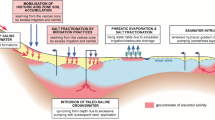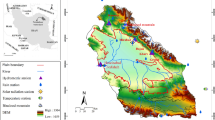Abstract
The long term sustainability of conjunctive water use for controlling irrigation salinity is affected by increase in groundwater salinity over time. This paper uses mass conservation of salt and water to assess groundwater degradation over long time scales. Management options which affect this rate of degradation are also examined. The groundwater model developed is illustrated using data from the Shepparton Irrigation Region in the Murray Basin, Australia. The model predicts rapid groundwater deterioration when conjunctive use is conducted over only a fraction of the area of influence of a groundwater pump. Where the pumped aquifer is underlain by deeper groundwaters, the rate of groundwater degradation is also affected by leakage into or out of the conjunctive use system. Surface redistribution of groundwater from pumps installed in zones of regional groundwater discharge to areas recharging the regional groundwaters, reduces excessive degradation in the zones of discharge. With optimal surface distribution of groundwater, the rate of degradation is low. The rate of groundwater degradation also depends on salt inputs from irrigation water and rainfall, and the average depth from the soil surface to the base of the aquifer. The rate of degradation resulting from applied salts in surface water and rainfall is typically about 0.01 dSm-1 per year for shallow aquifers in the Shepparton region, but the rate is lower where deeper aquifers are pumped. Partial irrigation also reduces the rate of degradation because of the reduced rate of salt inputs. Where poorer quality groundwater lies within the area of influence of the groundwater pump, a greater rate of deterioration in the quality of pumped groundwater can be expected from groundwater mixing. In some irrigation regions limited export of groundwater through surface water conveyance structures to a river is possible, so that a regional surface salt balance could be maintained. However, salt exports made equal to the rate of surface imports into the irrigated area will only significantly impact groundwater salinity in the very long term, or where only shallow aquifers can be pumped. In addition, this export can be costly for downstream water users, or if construction of additional conveyance infrastructure is extensive; export can have a detrimental impact on riverine ecosystems. Other management options such as the depth of pump installation and the spatial distribution of irrigation water and pumped groundwater, which affect the redistribution of salts within the groundwater system, have the potential to have a much greater impact on local groundwater salinity.
Similar content being viewed by others
References
Brown CM (1985) Murray Basin, South Eastern Australia: Stratigraphy and resource potential — a synopis. Bur Mineral Resour, Canberra, Aust, Rep 264
Brown CM, Stephenson AE (1986) Murray Basin subsurface stratigraphic database. Bur Mineral Resour, Canberra, Aust, Rep 262, 60 p
Domenico PA (1972) Concepts and models in groundwater hydrology. McGraw-Hill, 405 p
Doorenbos J, Pruit WO (1977) Crop water requirements. FAO Irrig and Drain Paper 24. FAO Rome 1984
Evans WR (1988) Preliminary shallow groundwater and salinity map of the Murray Basin. Bur Min Resour, Canberra, Australia
Fetter CW (1988) Applied Hydrogeology. Merrill Publishing Company, Columbus, Ohio USA, 43216, 592 p
Freeze RA, Witherspoon PA (1967) Theoretical analysis of groundwater flow. 2. The effect of watertable configuration and subsurface permeability variation. Water Resources Res 3:623–634
Heuperman AF (1986) The Tongala groundwater pumping and reuse project. Res Report No 17, Dept of Agric and Rural Affairs, Melbourne, Aust, pp 1–24
Heuperman AF (1988) The Tongala groundwater pumping and reuse project: a pilot study for groundwater table control in the Shepparton Region in Northern Victoria. Agric Water Manag 14:513–523
Hubbert MK (1940) The theory of groundwater motion. J Geol 48:785–944
Ife D (1988) Hydrogeological mapping of the upper Shepparton Formation, Shepparton Region. Report No 1988/29, Rural Water Commission, Melbourne, Aust, 41 p
Lawrence CR, Abele C (1976) Tertiary Murray Basin. In: Douglas JG, Ferguson JA (eds) Geology of Victoria. Spec Publn Geol Soc Aust 5:191–198
Macumber PG (1991) Interactions between groundwater and surface systems in Northern Victoria. Dept Conservation and Environment, Melbourne, Aust
Murray Darling Basin Ministerial Council (1987) River salinity waterlogging and land salinisation — towards an integrated management strategy. Tech Rep No 87/1, Canberra, Aust, 90 p
Nolan J, Reid M (1989) The role of the deep lead pumping for salinity control and resource development within the Shepparton region. Rural Water Comm Rep No 1989/11, 33 p
Prendergast JB (1989) Mallee groundwater. In: Noble J, Bradstock J (eds) Mediterranean Landscapes in Australia: Mallee Ecosystems and their Management. CSIRO, Melbourne, Aust, pp 54–79
Prendergast JB, Heuperman AF (1988) Groundwater pumping/reuse in N. Victoria: recharge processes, aquifer salinisation and farm productivity. BMR J Aust Geol Geophys, Groundwater 12:149–154
Prendergast JB, Noble CL (1990) The effect of groundwater reuse on infiltration and groundwater recharge under an irrigated perennial pasture. Proc Murray-Darling 1990 Workshop: Groundwater Research and Management. Mildura, 13–15 Nov 1990. NSW Dept Wat Resour Rep 90.038, Sydney, Aust
Prendergast JB, Rose CW, Hogarth WL (1994) A model for conjunctive use of groundwater and surface waters for control of irrigation salinity. Irrig Sci 14:187–197
Salinity Program Advisory Council (1989) Draft Shepparton land and water salinity management plan. Govt of Vic, Melbourne, Aust, 151 p
Todd DK (1980) Groundwater hydrology. J Wiley and Sons, Inc, New York, London, 33 p
Author information
Authors and Affiliations
Rights and permissions
About this article
Cite this article
Prendergast, J.B., Rose, C.W. & Hogarth, W.L. Sustainability of conjunctive water use for salinity control in irrigation areas: theory and application to the Shepparton region, Australia. Irrig Sci 14, 177–187 (1994). https://doi.org/10.1007/BF00190189
Received:
Issue Date:
DOI: https://doi.org/10.1007/BF00190189




